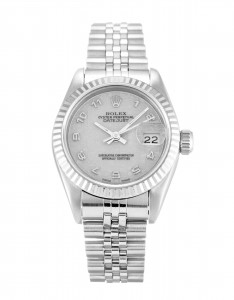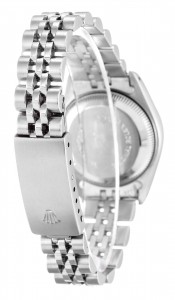 We looked at the main differences between the last steel Pepsi and the new white gold model back of the replica Rolex watches several years ago, but it’s worth reviewing one more time in the context of the new model, particularly as there are technical updates to the new steel Pepsi over the white gold version. To begin with, the new model has the Cerachrom Pepsi bezel that released on the white gold model in 2014, which provides quite a bit technically vs. the aluminum bezel – it’s for all intents and purposes scratchproof, and the colors won’t fade any more.
We looked at the main differences between the last steel Pepsi and the new white gold model back of the replica Rolex watches several years ago, but it’s worth reviewing one more time in the context of the new model, particularly as there are technical updates to the new steel Pepsi over the white gold version. To begin with, the new model has the Cerachrom Pepsi bezel that released on the white gold model in 2014, which provides quite a bit technically vs. the aluminum bezel – it’s for all intents and purposes scratchproof, and the colors won’t fade any more.
It’s wider than the old bezel and doesn’t have its mid-20th century anachronistic charm – the anodized aluminum bezel has been around since 1959 – but as with most of the changes Rolex makes to existing models, it’s unquestionably a better choice from a technical materials standpoint.
Among the advantages of the Chronergy escapement are an upgraded lever geometry and skeletonized escape wheel for better efficiency, as well as the use of a non-magnetic nickel-phosphorus alloy for both parts. Certainly, the other big difference between the new steel GMT-Master II and previous models – and one which will be for owners far more noticeable than the movement – is the Jubilee bracelet.
The Jubilee bracelet is an interesting piece of Rolex history on its own, even apart from the GMT-Master/GMT-Master II watches. It was introduced by Rolex in 1945, on the Datejust. The Jubilee bracelet was also the very first in-house Rolex bracelet, the company having formerly relied on Gay Frères. 
The Jubilee bracelet on a fake Pepsi-bezel GMT is the single most divisive factor of the watch. Like all modern Rolex bracelets, it’s a perfectly engineered piece of gear, with best-in-class fit and finish. However, it’s also a bit more ornamental than an Oyster bracelet, and it would seem that the relative sobriety of the GMT-Master II should call for the more austere look of the Oyster. It’s not really a comfort issue – the Jubilee bracelet should theoretically offer better conformance to the shape of the wrist, thanks to the smaller links but as anyone who’s worn a modern Oyster bracelet will tell you, they take a back seat to no one in terms of ease of adjustment and general wearability. So why offer the steel Pepsi GMT II on a Jubilee bracelet only – and besides, one that cannot be swapped out for an Oyster bracelet?
As the steel version may very well be much more difficult to find than the white gold, this is apt to make the Jubilee bracelet an attractive option for prospective owners, who will likely be pleased as Punch to be able to instantly signal that they’ve got such a relatively amazing replica Rolex. Though in the abstract one might prefer the Oyster bracelet as more, so to speak, ideologically pure, I have very sincere doubts as to whether the Jubilee will hurt sales of the steel Pepsi GMT II one iota.